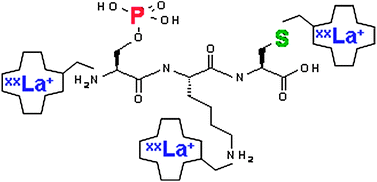Besides the qualitative analysis of a bio-molecule or even a whole proteome, their quantitative determination is also a topic of growing interest, since only the quantity of proteins or changes in their abundance really reflects the status and changes of a biological system. Various approaches have recently been suggested for the comparative investigation of different sample states resulting in different proteomes (comparative proteomics) on the basis of either relative or absolute protein quantification. These use molecule specific mass spectrometry and stable isotope labels with different chemical properties, which are covalently bound to, or incorporated in vivo into the various protein species within the sample entities compared. Various groups in the field of analytical atomic spectrochemistry have recently been developing new strategies and analytical tools for the complementary implementation of elemental mass spectrometry (e.g. inductively coupled plasma mass spectrometry (ICP-MS)), which is still generally known as only a “metal” detector, in new, “non-traditional” application areas targeting bio-molecular chemistry or even the fast growing field of proteomics related research, which is currently dominated by ESI or MALDI based MS techniques. At this time, three main strategies are emerging for the complementary application of ICP-MS to bio-molecule quantification in life-sciences orientated research. These include (i) the utilisation of natural (hetero) element tags (covalently bound elements e.g. sulfur and phosphorus), which are present in nearly all protein bio-molecules, (ii) the controlled labelling of bio-molecules such as proteins, peptides or antibodys with ICP-MS detectable elements using bi-functional chelating agents (by means of a chemical reaction, which forms a covalent bond between the chelating agent and a specific functional site of the bio-molecule) and (iii) the chemical labelling of bio-molecules with nano-particles which contain elements detectable by ICP-MS. The idea behind all three strategies is to make bio-molecules detectable by ICP-MS and thus benefit from its high sensitivity, linearity and matrix robustness. This would allow the qualitative detection and quantitative determination of nearly all bio-molecules provided the stoichiometry of either the natural tag or the chemical label is known. This article will give a critical review of the latest developments in the field of quantitative proteomics and will highlight key applications of ICP-MS as a complementary tool to ESI or MALDI MS techniques for selected proteomics or biochemistry related applications. Special emphasis is placed on the quantification of bio-molecules using elements that are covalently bound to proteins or peptides and which show wide distributions in these bio-molecules as tags.

You have access to this article
 Please wait while we load your content...
Something went wrong. Try again?
Please wait while we load your content...
Something went wrong. Try again?


 Please wait while we load your content...
Please wait while we load your content...